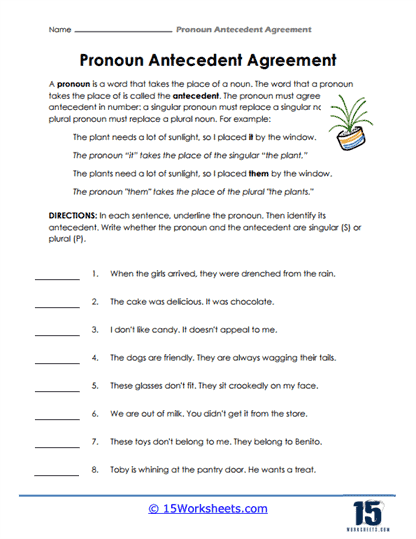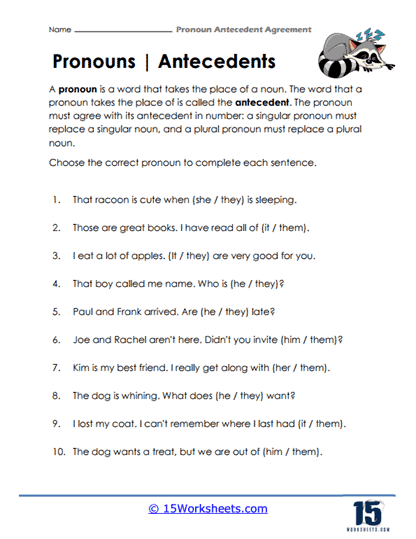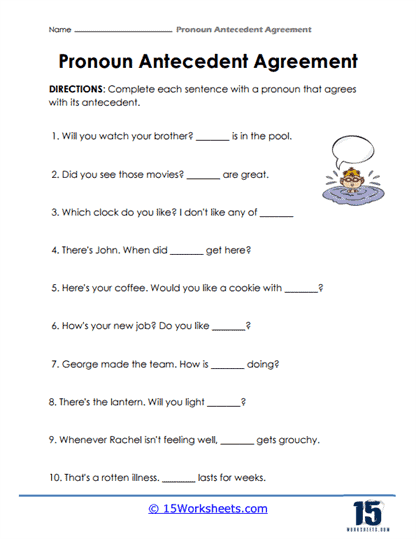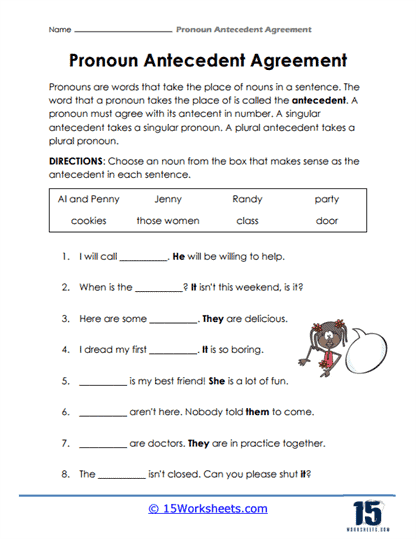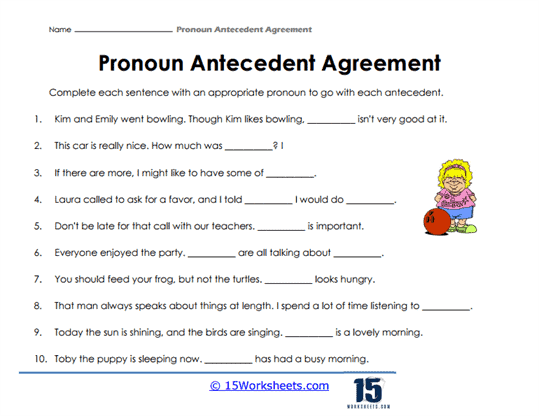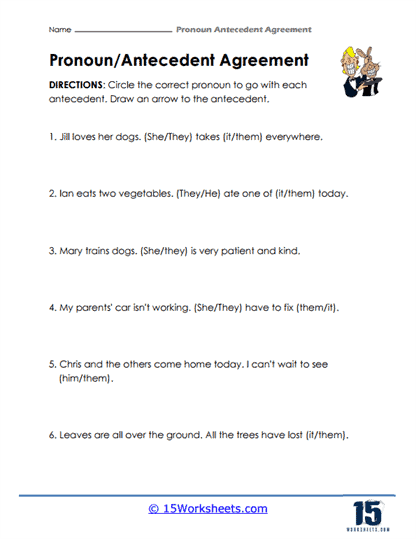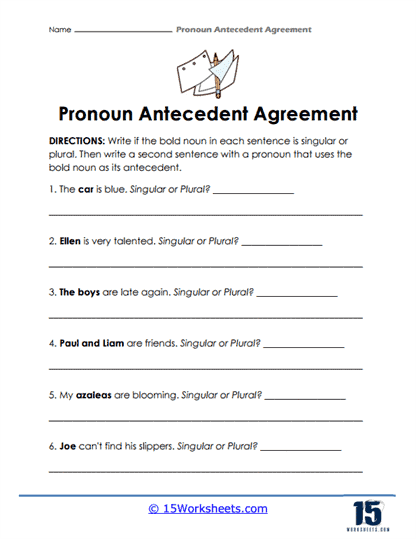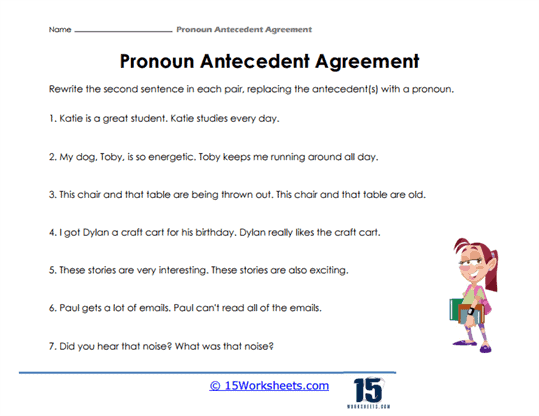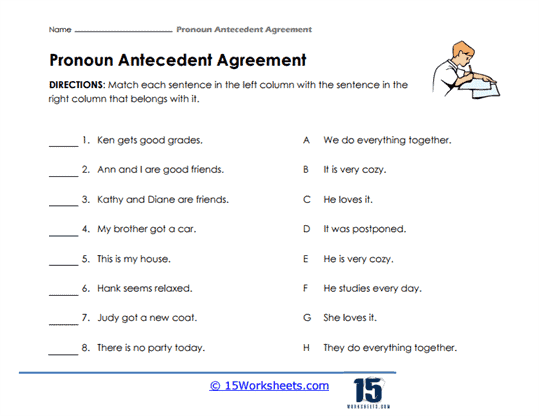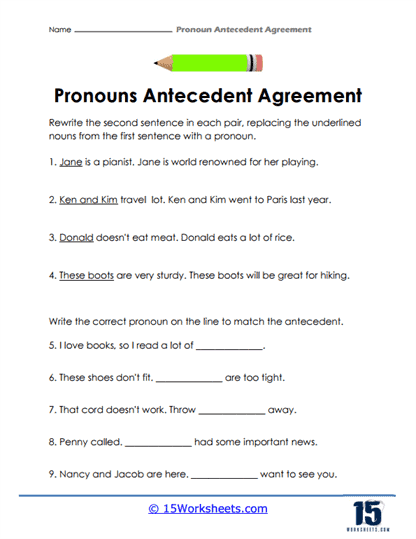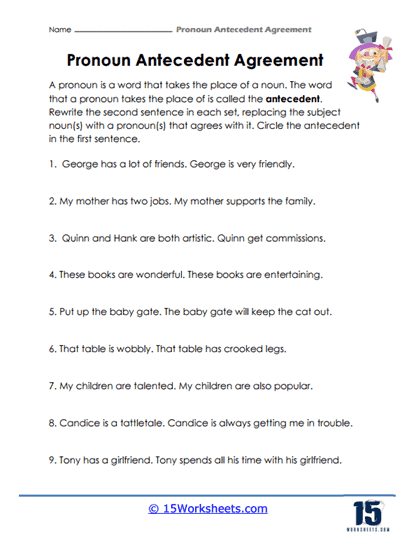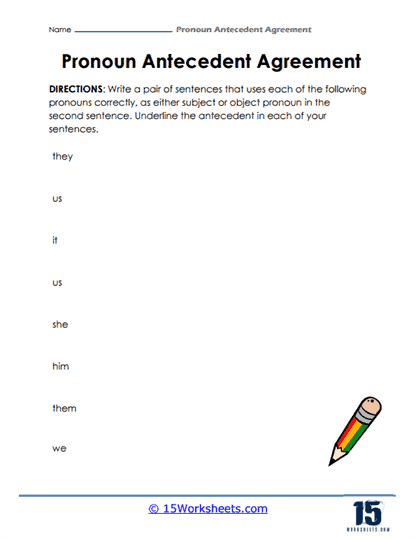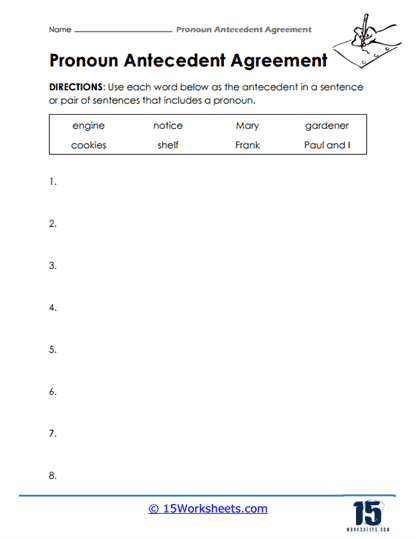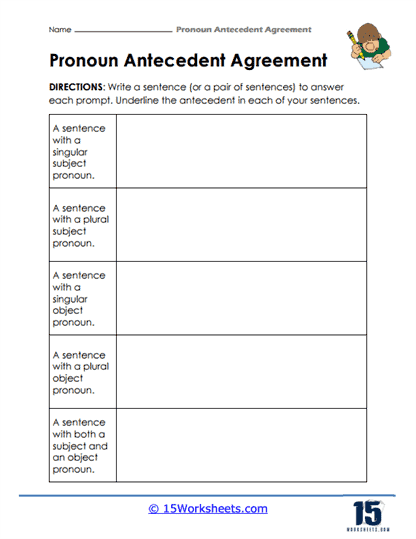Pronoun Antecedent Agreement Worksheets
All About These 15 Worksheets
These pronoun-antecedent agreement worksheets are a helpful tool for teaching and reinforcing this important aspect of English grammar. Pronoun-antecedent agreement refers to the relationship between a pronoun and the noun or pronoun that it replaces, known as the antecedent.
These worksheets include examples and exercises to help students identify correct and incorrect pronoun-antecedent agreement in sentences. They also include activities such as filling in the blanks with the correct pronoun, rewriting sentences to correct errors in agreement, and identifying antecedents in sentences. Through these worksheets, students will:
- Identify antecedents in sentences;
- Complete sentences by supplying them with pronouns that agree with their corresponding antecedents;
- Understand the rules of pronoun antecedent agreement;
- And write their own sentences that observe the rules of pronoun antecedent agreement.
By completing these worksheets, students can develop a better understanding of how pronoun-antecedent agreement works and how to use pronouns correctly in their writing and speaking. This can help them improve their communication skills and avoid common errors that can lead to confusion or ambiguity.
How Do You Check for Pronoun Antecedent Agreement?
A pronoun’s antecedent is a noun or even a noun substitution it refers to. For example, Jamie is an antecedent, and “her” is a pronoun in the sentence: Jamie ended her class in June. Pronouns ought to be consistent with their antecedents in terms of number, person, and gender. The pronoun must be singular if the preceding is. The pronoun must be plural if the antecedent is too.
The following advice will be helpful in the unique circumstances that are the most likely to result in issues.
Antecedents for Indefinite Pronouns
Pronouns with an ambiguous referent are known as indefinite pronouns. The pronouns that come after the subsequent indefinite pronouns should be single and gender-neutral except if the gender identification of the people is known.
- either, each, either one, each one, neither
- anyone, anything, everyone, anybody, neither one
- something, somebody, someone, everybody
- nobody, no one, none, everything
Anybody who has completed their exam is free to go.
Everyone on the squad gave it their all.
Neither person at his meal.
Two Singular Antecedents
A plural pronoun is often required when two or even more antecedents are connected by and.
He had parked his vehicle and boat where they always were.
Omar, Jackie, and Daniel finished their presentation five minutes early.
The pronoun must, however, be singular as each or every comes before the antecedents.
Every household and company has to do its share to save energy.
(Every requires a single pronoun.)
The legislature received the budget requests from each institution and university.
(Each requires the use of a single pronoun.)
Singular pronouns are required after singular antecedents connected by or, either and or, or neither and nor.
Has either Paul and Dany completed his reports yet?
Neither Jonna nor Donna has finished her packing for the vacation.
Singular antecedents need to be followed by the pronoun when the gender of the subject is ambiguous or nonbinary.
Has either Paul or Dany completed their reports?
Neither Jonna nor Donna has finished their packing for vacation yet.
Plural and Singular Antecedents
The pronoun corresponds in number with the nearest antecedent if one singular or a plural antecedent are connected by or, either and or, or neither and nor.
Either Jenna or our uncles will give us their car.
In agreement with a plural antecedent “uncles,” the pronoun their is used.
Either Jenna or our uncles will give us her car.
Her corresponds with a singular antecedent, “Jenna” in the pronoun.
Sometimes the antecedents must be written in a certain sequence in order to convey the appropriate meaning.
Neither Timothy nor the managers were aware of their perils.
Their is in agreement with a plural antecedent “managers” in the sentence.
Neither Timothy nor the managers were aware of his perils.
In agreement with a singular antecedent “Timothy,” the pronoun his is used.
Observe how these phrases’ meanings change. In the first part, everyone is in danger. In the latter, only the superintendent—who uses the pronouns he/his-is in danger.
Antecedents for Collective Nouns
Despite having a single form, collective nouns indicate a collection of people or objects. A singular pronoun should be used to allude to a collective noun if it is thought of as one entity. The pronoun must be plural if the collective noun is thought of as a collection of persons operating independently.
The group made their decision public.
The team is working together.
Yesterday, the group signed their contract.
The group is posing as a single entity.
Using “They” in the Singular
When referring to a single representative, use a singular “they” pronoun. Consider “a person,” “an individual,” “the usual pupil,” or “an ordinary American,” which may refer to a variety of genders as a single noun.
Regarding language usage, one should always be cautious.

